Recently, we have seen a number of students coming to SFG Certifications who clean and swing with their thumbs up. I am here to put an end to this fashion.
The Proper Thumb Position for StrongFirst
Other kettlebell systems have been known to use a variety of fist positions and they often have good reasons in their own context. For instance, keeping the thumbs up at all times is an efficient way to clean when you are going for 100 reps. For StrongFirst, this grip is unacceptable. We are after power, not reps. And when you attempt to move kettlebells fast with the hammer grip, you are risking injuring your elbows on the bottom of the backswing. You could literally arm-bar yourself.
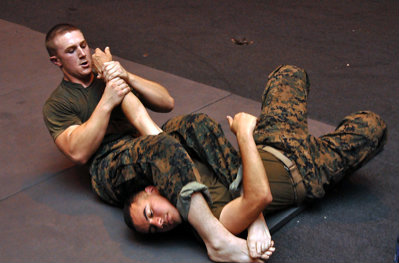
At the SFG Certification, we teach starting the clean with the thumb pointing slightly down, about seven to eight o’clock for the right arm. For doubles, we are looking for a very open “V.” A “V” opens up more space between your legs when you clean heavy doubles.
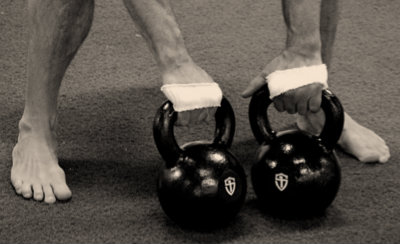
A “barbell” grip, with the handles in line and the palms facing straight down, is totally acceptable for a beginning girevik. Once you get stronger though, you might find it difficult to pass a pair of heavy kettlebells between your legs.
You may have seen Geoff Neupert, Master SFG, employ yet another grip: keeping the thumbs turned up to ten and two o’clock. Like the classic “V,”an inverted “V” gives large kettlebells more space to pass between the legs. An additional benefit, points out Geoff, is that this grip prevents some gireviks, especially big-chested ones, from rounding their upper backs and unpacking the shoulders on the bottom of a clean. The inverted “V” is an individual choice of an advanced practitioner, not an SFG standard. Because, like with a hammer grip, there is a risk of injuring your biceps.
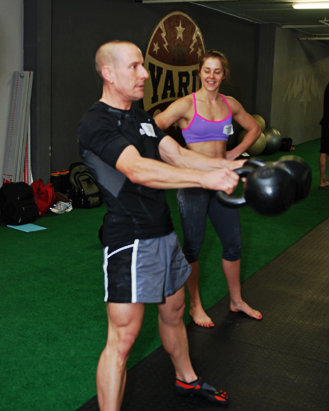
Thumb Position and Lat Engagement
The proponents of the hammer grip like to argue that it allows them to engage their lats more. You may have noticed the connection between the wrist and the shoulder rotation—the former tends to drive the latter. This is why the hammer and the inverted “V” make it easier to screw your shoulders into their sockets. The fist turns and turns the shoulder in turn.
Jon Engum, Master SFG and a high-level martial artist, is not impressed: “I can engage my lat in a punch with a horizontal fist just as well as a vertical fist.” Neurologically, you should be able to disassociate the movement of these two joints—turning one does not have to turn the other.
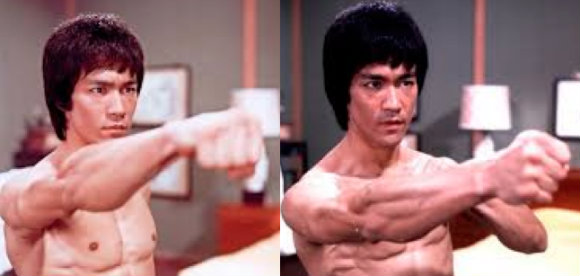
Here is a drill to teach you how to do this:
Stand up and straighten out one arm in front of you, its palm facing down. Maximally rotate your shoulder (external rotation) and your wrist (supination) until your palm faces up. Note the tight “screwed in” sensation in the shoulder.
Repeat the above drill—turn your palm up and screw your shoulder into its socket. Anti-shrug your shoulder with your lat. Note the tight sensation in your armpit. Without losing this sensation and without disturbing the shoulder alignment slowly turn your palm down.
Power to your pulls!
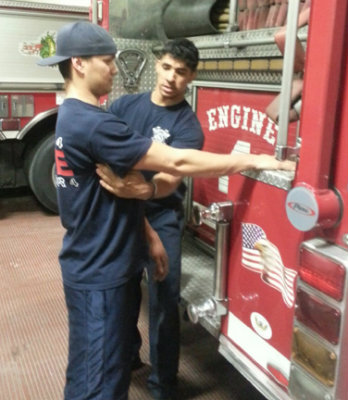
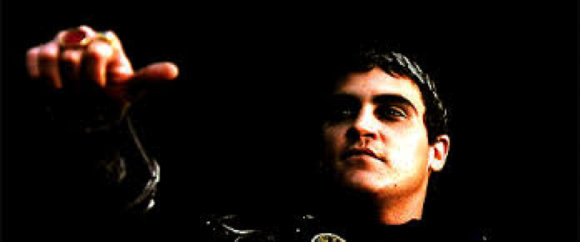
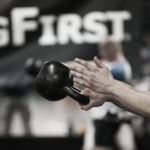
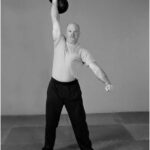
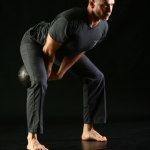


I just saw this blog post – I had been struggling with my 1H swings when keeping my palm totally flat R thumb at 9 o’clock and I read in jeff martone’s kettlebell rx that leading back with the thumb to a 6 oclock (my interpretation not exactly what he wrote) at the end of the back swing and more like a 10 oclock at chest level was the way to go. I found the movement felt better for me when I used this thumb to 6 in the back swing, though at chest level I like the 9 oclock R thumb, because I use the photo you have of yourself on the cover of S&S as my guide. but, what I am reading here is that I am potentially putting myself in an injurious position with my R thumb at 6 on the backswing. is that your view?
after reading through ETK and S&S I see where you state to grab the handle in the middle. through practice I am now comfortable with the proper drawback , basically straight back with R thumb pointed at 9 o’clock ( I may naturally twist it down to 8 or 7, but not deliberately) and I finish the same way. thank you for providing all that we need.
Can you please add a video on the subject?
This is a wonderful explanation for training “external rotation” of the shoulder not only during the kettlebell clean, but during a possible pull movement as well. As a fellow strength coach I’m always communicating the importance of training external rotation during such lifts, and trying to drive home the importance of not reinforcing an already overused internal rotating movement due to typical lifestyle factors and every gym rat’s favorite exercise of the upright row. Very good article. Thanks for sharing!
A small correction. I meant to say “This is a wonderful explanation for training “external rotation” of the shoulder not only during the kettlebell clean, but during other pull movements as well.” Sorry for the typo in that line. Thanks again.
Can this be a beginner guide?
Hakana, please clarify your question.
pavel wow need more work in this subject
I guess I’m more than a little confused. I had understood that one of the changes in the move from RKC to SFG was the change in the position of the hand for the clean, double swings and snatch. That turning the palm in — which I guess is the same as putting the thumb up — produces a more efficient movement.
Ian, the inverted “V” is a very good way to go—when you have spent your time lifting bells .
Nick, do not overthink it in the get-up. Just keep the shoulder packed.
Gladly!
Very interesting. Will practice it this way from now on.
Not trying to change the subject, but what about get-ups during the first quarter to half of the movement–and, by extension, the last quarter to half)? I feel like I see some instructional videos where the bell is held in a horizontal fist (i.e., bell laying on arm facing toward shoulder/head), and others where the fist is either at a diagonal angle or vertical (bell laying away from body to some degree). Apologies if the orientation described isn’t clear…